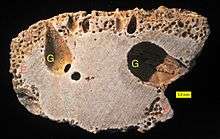Gastrochaenolites
Gastrochaenolites is a trace fossil formed as a clavate (club-shaped) boring in a hard substrate such as a shell, rock or carbonate hardground. The aperture of the boring is narrower than the main chamber and may be circular, oval, or dumb-bell shaped (Kelly and Bromley, 1984). Gastrochaenolites is most commonly attributed to bioeroding bivalves such as Lithophaga and Gastrochaena (Kleeman, 1980). The fossil ranges from the Ordovician to the Recent (Taylor and Wilson, 2003; Vinn and Wilson, 2010). The first Lower Jurassic Gastrochaenolites species is Gastrochaenolites messisbugi Bassi, Posenato, Nebelsick, 2017. This is the first record of boreholes and their producers (mytilid bivalves) in one of the larger bivalves of the globally occurring Lithiotis fauna which is a unique facies in the Lower Jurassic Tethys and Panthalassa.

References
- Kelly, S.R.A., Bromley, R.G. (1984). "Ichnological nomenclature of clavate borings". Palaeontology. 27: 793–807.CS1 maint: multiple names: authors list (link)
- Kleemann, K.H. (1980). "Boring bivalves and their host corals from the Great Barrier Reef". Journal of Molluscan Studies. 46: 13–54.
- Taylor, P.D., Wilson. M.A. (2003). "Palaeoecology and evolution of marine hard substrate communities". Earth-Science Reviews. 62: 1–103. doi:10.1016/S0012-8252(02)00131-9.CS1 maint: multiple names: authors list (link)
- Vinn, O.; Wilson, M.A. (2010). "Early large borings from a hardground of Floian-Dapingian age (Early and Middle Ordovician) in northeastern Estonia (Baltica)". Carnets de Géologie. 2010: CG2010_L04. doi:10.4267/2042/35594. Retrieved 2014-06-10.
- Bassi, D., Posenato, R., Nebelsick, J.H., Owada, M., Domenicali, E., Iryu, Y. (2017). "Bivalve borings in Lower Jurassic Lithiotis fauna from northeastern Italy and its palaeoecological interpretation". Historical Biology. 29: 937–946. doi:10.1080/08912963.2016.1265956.CS1 maint: multiple names: authors list (link)